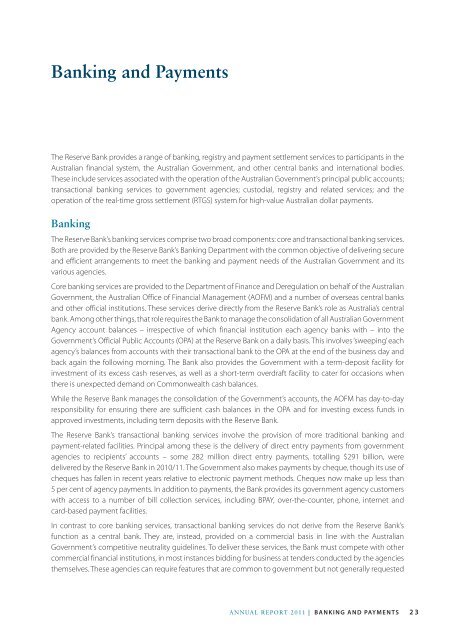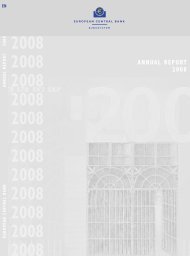Reserve Bank of Australia Annual Report 2011
Reserve Bank of Australia Annual Report 2011
Reserve Bank of Australia Annual Report 2011
You also want an ePaper? Increase the reach of your titles
YUMPU automatically turns print PDFs into web optimized ePapers that Google loves.
<strong>Bank</strong>ing and Payments<br />
The <strong>Reserve</strong> <strong>Bank</strong> provides a range <strong>of</strong> banking, registry and payment settlement services to participants in the<br />
<strong>Australia</strong>n financial system, the <strong>Australia</strong>n Government, and other central banks and international bodies.<br />
These include services associated with the operation <strong>of</strong> the <strong>Australia</strong>n Government’s principal public accounts;<br />
transactional banking services to government agencies; custodial, registry and related services; and the<br />
operation <strong>of</strong> the real-time gross settlement (RTGS) system for high-value <strong>Australia</strong>n dollar payments.<br />
<strong>Bank</strong>ing<br />
The <strong>Reserve</strong> <strong>Bank</strong>’s banking services comprise two broad components: core and transactional banking services.<br />
Both are provided by the <strong>Reserve</strong> <strong>Bank</strong>’s <strong>Bank</strong>ing Department with the common objective <strong>of</strong> delivering secure<br />
and efficient arrangements to meet the banking and payment needs <strong>of</strong> the <strong>Australia</strong>n Government and its<br />
various agencies.<br />
Core banking services are provided to the Department <strong>of</strong> Finance and Deregulation on behalf <strong>of</strong> the <strong>Australia</strong>n<br />
Government, the <strong>Australia</strong>n Office <strong>of</strong> Financial Management (AOFM) and a number <strong>of</strong> overseas central banks<br />
and other <strong>of</strong>ficial institutions. These services derive directly from the <strong>Reserve</strong> <strong>Bank</strong>’s role as <strong>Australia</strong>’s central<br />
bank. Among other things, that role requires the <strong>Bank</strong> to manage the consolidation <strong>of</strong> all <strong>Australia</strong>n Government<br />
Agency account balances – irrespective <strong>of</strong> which financial institution each agency banks with – into the<br />
Government’s Official Public Accounts (OPA) at the <strong>Reserve</strong> <strong>Bank</strong> on a daily basis. This involves ‘sweeping’ each<br />
agency’s balances from accounts with their transactional bank to the OPA at the end <strong>of</strong> the business day and<br />
back again the following morning. The <strong>Bank</strong> also provides the Government with a term-deposit facility for<br />
investment <strong>of</strong> its excess cash reserves, as well as a short-term overdraft facility to cater for occasions when<br />
there is unexpected demand on Commonwealth cash balances.<br />
While the <strong>Reserve</strong> <strong>Bank</strong> manages the consolidation <strong>of</strong> the Government’s accounts, the AOFM has day-to-day<br />
responsibility for ensuring there are sufficient cash balances in the OPA and for investing excess funds in<br />
approved investments, including term deposits with the <strong>Reserve</strong> <strong>Bank</strong>.<br />
The <strong>Reserve</strong> <strong>Bank</strong>’s transactional banking services involve the provision <strong>of</strong> more traditional banking and<br />
payment-related facilities. Principal among these is the delivery <strong>of</strong> direct entry payments from government<br />
agencies to recipients’ accounts – some 282 million direct entry payments, totalling $291 billion, were<br />
delivered by the <strong>Reserve</strong> <strong>Bank</strong> in 2010/11. The Government also makes payments by cheque, though its use <strong>of</strong><br />
cheques has fallen in recent years relative to electronic payment methods. Cheques now make up less than<br />
5 per cent <strong>of</strong> agency payments. In addition to payments, the <strong>Bank</strong> provides its government agency customers<br />
with access to a number <strong>of</strong> bill collection services, including BPAY, over-the-counter, phone, internet and<br />
card-based payment facilities.<br />
In contrast to core banking services, transactional banking services do not derive from the <strong>Reserve</strong> <strong>Bank</strong>’s<br />
function as a central bank. They are, instead, provided on a commercial basis in line with the <strong>Australia</strong>n<br />
Government’s competitive neutrality guidelines. To deliver these services, the <strong>Bank</strong> must compete with other<br />
commercial financial institutions, in most instances bidding for business at tenders conducted by the agencies<br />
themselves. These agencies can require features that are common to government but not generally requested<br />
ANNUAL REPORT <strong>2011</strong> | <strong>Bank</strong>ing and Payments<br />
23





![KNOW YOUR NEW GIBRALTAR BANKNOTES - [Home] bThe/b](https://img.yumpu.com/50890985/1/184x260/know-your-new-gibraltar-banknotes-home-bthe-b.jpg?quality=85)
![PAPUA NEW GUINEA - [Home] - Polymer Bank Notes of the World](https://img.yumpu.com/49758743/1/190x143/papua-new-guinea-home-polymer-bank-notes-of-the-world.jpg?quality=85)










